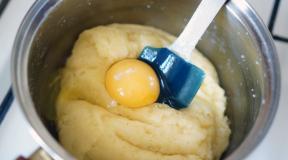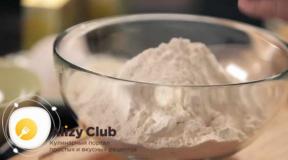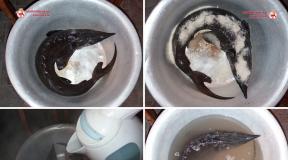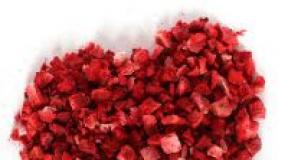Flower tea for women from rose buds. What are the benefits of roses for human health
The tea rose is an ornamental plant derived from the wild rose. Tea rose petals are used in folk medicine for the preparation of various decoctions, medicinal tinctures and aromatic drinks. Due to the impressive amount of vitamins (C, D, E, PP), minerals (calcium, iron), essential oils and other useful substances, medicines based on it have a healing effect. Rose petals are used in the fight against respiratory diseases, improve the functioning of the gastrointestinal tract, and also have a good cosmetic effect.
- cleansing the body of toxins;
- relief from sore throat and runny nose;
- protection against various infections;
- restoration of normal intestinal microflora;
- removal of excess fluid from the body;
- improving kidney function;
- help in getting rid of dysentery and diarrhea;
- beneficial effect on the liver;
- regulation of the menstrual cycle;
- getting rid of depression, sleep problems and stress.
- women who are carrying or breastfeeding a child;
- children under the age of three;
- people suffering from hypertension.
- ARI, SARS;
- infectious diseases of the stomach, kidneys, liver and intestines;
- constipation;
- stomatitis and inflammation of the gums;
- swelling;
- skin diseases (acne, psoriasis, eczema, non-healing wounds).
- 2 tsp vegetable raw materials;
- 200 ml of boiling water.
- 3 art. l. vegetable raw materials;
- 2.5 cups of boiling water.
- take chamomile and calendula flowers, tea rose petals, cudweed and horsetail in equal parts (10 g each);
- add grass agrimony, leaves of panicled wormwood, rose hips, dill seeds, St. John's wort and plantain in equal parts (20 g each);
- 70 g of yarrow are added to the resulting collection;
- 6 g is separated from the mixture and poured with 0.5 l of boiling water;
- boil the mixture for 30 minutes in a water bath.
- stomach ulcer and duodenal ulcer (use a teaspoon on an empty stomach in the morning and evening a couple of hours before meals);
- bronchial asthma (a teaspoon three times a day 60 minutes before eating);
- allergic rhinitis (a teaspoon twice a day one hour before meals, lubrication of the nasal passages three times a day).
- take 1 kg of vegetable raw materials, 3 kg of sugar and 1 liter of water;
- pour water into a container, pour sugar and cook them until the sugar dissolves;
- after complete dissolution of granulated sugar, fill in the petals of a tea rose;
- stir the mixture and boil well for 5 minutes;
- remove the container from the heat and let the mixture cool;
- boil the jam again and cool it;
- add a couple of slices of lemon and boil again.
- 1. Mask for normal skin type. To prepare it, you will need to take egg white, petal powder in the same amount (1 tsp each) and a dessert spoon of sour cream or cream. After mixing the components, they need to be allowed to brew for 5 minutes, and then applied to the décolleté and face for 25 minutes, then rinse with warm water.
- 2. Rose water for washing. It is necessary to take half a tablespoon of dried petals and 1 tbsp. l. glycerin. Petals should be poured with a glass of boiling water and removed in a dark place for 24 hours. After a day, the infusion must be filtered and glycerin added to it. You need to use ready-made rose water during the morning and evening washing.
- 3. Mask for all skin types. This product, when used regularly, will help to moisturize the skin of the face. To prepare it, you need to take in equal parts fresh cucumber juice and cream (one tablespoon each) and a couple of tablespoons of ready-made rose water. All components must be mixed and applied to the face in a thick layer for 30 minutes, then rinsed off.
Show all
Useful properties and contraindications
Regular consumption of drinks from tea rose petals has a beneficial effect on the immune, nervous and digestive systems. A healing agent is also prepared from vegetable raw materials, which helps to solve problems with the thyroid gland. Among the main useful properties of tea roses are the following:
Rose petals have found their application in cosmetology. They are used to make ointments, oils, creams, masks, shampoos and medicinal water. With the petals of this flower, they also take relaxing baths, after which skin cells are actively restored.
Despite the obvious benefits of tea rose, its use can be harmful to the body. The following groups of people have contraindications to the use of medicines from rose petals:

Application in traditional medicine
Healing agents that are prepared on the basis of this plant material have a bactericidal, diuretic, laxative and antiviral effect. In folk medicine, the plant is used to treat the following diseases:

rose petal tea
To make tea from the petals you will need to take:
It is necessary to pour vegetable raw materials with water, and let the tea brew for 10-20 minutes. It is desirable to use it hot. Thanks to its antiseptic properties, soothing and antiviral action, the remedy will help you quickly recover from a cold, reduce inflammation of the intestinal and stomach mucosa, and calm the nervous system.

Rose petal infusion
A rose petal-based remedy is used to prepare skin lotion, herbal baths that soothe the nervous system and to treat wounds and bedsores. To make it, you need to take:
Rose petals should be poured into a thermos with water and left to infuse until morning. After the allotted time, the remedy must be filtered and consumed half a cup three times a day, 30 minutes before meals. Infusion can also rinse the mouth and throat with stomatitis and diseases of the upper respiratory tract.
Decoction for ulcers and gastritis
Healing herbal collection will help with diseases of the gastrointestinal tract. The decoction is prepared as follows:
Ready broth must be filtered and consumed orally four times a day, 20 minutes before meals.
rose oil
Rose oil helps to relieve the inflammatory process, so it is used to treat the following diseases:

Making butter at home is quite simple. She will need to take fresh rose petals and olive oil heated to 70 degrees. In the absence of fresh tea rose petals, you can take dry ones and, putting them in a glass container, pour oil over them. The container with oil must be placed in a dark place for a couple of days. After the allotted time, the oil must be filtered and filled with the next portion of rose petals. The procedure must be repeated until the oil acquires a pleasant persistent smell of roses. As a rule, the number of procedures does not exceed 15. The finished oil should be stored in the refrigerator for no more than 5 months from the date of manufacture.
Preparing jam
There are several recipes for tea rose petal jam. Rose petal jam will help to cope with a cold and will be a healthy treat for the whole family. To make jam with petals and sugar you will need:
The next recipe will use honey instead of sugar. Preparing honey rose jam as follows:
Rose petals are widely used not only in traditional medicine recipes, but also for cosmetic purposes. From them you can prepare various masks for almost any type of skin, as well as cosmetic water and lotion. Among the most popular products that are easy to make at home, the following can be distinguished:
Regular use of face masks and lotions based on tea rose petals will help make the skin fresh, velvety and attractive.
Soothes
Improves sleep
uplifting
Therapeutic effect
Anti-inflammatory and antimicrobial action
Strengthens the immune system
Body detoxification
Helps to get rid of excess weight
Place of production
general information
Chinese rose buds or Meigui Hua is the most delicate addition to pu-erh, white teas and oolong teas, as well as an exquisite independent drink. All of China idolizes these charming buds, carefully grown in the Shandong province. Their fragrance, bright rich taste and visual elegance will create for you a tea party in Heaven - impeccably gentle, delicate, opening up new facets of taste.
If you consider yourself a connoisseur and connoisseur of tea culture, you should definitely drink this fragrant soft pink drink. And be sure to try rosebuds as an addition to your favorite tea.
Infusion color
Light pink.
Taste and aroma
Airy, sweet taste with a long delicate aftertaste. Very nice, strong, floral scent! Natural rose oils are revealed with tea leaves in full force.
Beneficial features
Chinese rose buds contain an abundance of essential oils that have anti-inflammatory and antimicrobial effects, which helps in the fight against colds. Rose infusion rejuvenates every cell of the body and evens out skin tone. Also, the Chinese rose is rich in vitamin C - a faithful assistant to immunity. And the indescribable aroma has a beneficial effect on the emotional state.
Story
When did Chinese rose buds begin to be brewed in China? Many centuries ago, and still! Roses adorn life with a sweet fragrance, and transparent gaiwans with gently blossoming buds.
Giving roses is not only putting a bouquet of flowers in your hands, it is also a kind of declaration of love. In order for the rose to absorb all the beauty intended for it by nature, we carefully and lovingly care for it at every stage of its cultivation: from the greenhouse to the boutique.
I/ Dialogue of professionals
Every day in the greenhouse begins with the most important questions: how do the flowers grow, what causes concern, are the plants healthy? Have insects appeared on them? In the photo, experts examine glue traps for insects, by which agronomists determine whether there is greenhouse pests. The greenhouse is divided so that the phytosanitary situation in any place is absolutely clear to specialists.
II/Greenhouse. Harvest of the Peony Rose by Yves Piaget.

Cutting roses is an important operation, it is done two to three times a day. Speed and accuracy are very important here. The florist carefully holds the flowers in front of him like his child - in order not to damage them.
III/Harvest. Rose cut Coffee break.
IV/ Harvest of Norma Jean. Mesh packaging.

The critical time from the beginning of cutting one variety to the moment when the flowers are wrapped in a net is three minutes. The netting is the scaffold that is supposed to protect the flowers, so it is a hard, soft craft that is placed on top of the netting to help keep the petals intact.
V/ Sending to the refrigerator: Creme Piaget roses in nets are sent to the refrigerator already on the water.

The maximum time during which the flowers must be sent to the refrigerator is 15 minutes. All grids are placed in tanks with clean water prepared in advance, cooled to 4 degrees.
VI/ Cooling

6 hours is the minimum time that flowers should spend in the refrigerator. This operation is necessary to preserve the flowers and ensure their long vase life. During these 6 hours, all the biological processes of the flower slow down, so then they open much more slowly.
VII/ Sorting is carried out in two stages.
First, the flowers are sorted by length, and then by quality - according to the high criteria "Rose Fairy". In total, the flowers will be out of the refrigerator for only 15 minutes.
Grid opens

Length: flowers will first be sorted by length - from 30 to 90 centimeters. When sorting, the buds should never touch the table.
Wood flooring is, of course, too hard for flowers. For the safety of the petals, soft cardboard is always enclosed.
VIII/ Sorting - Quality and packaging
Everything is arranged so that the buds do not touch the table. They will only be in contact with craft packaging material.
The sorter has received all flowers of the same length and checks each rose for quality standards. She then packs them into bundles to be delivered to the customer.
When packing, it is important to choose the right side of the stem on which it is most comfortable, bud to bud, the next stem will be laid. They should lie tight enough - so as not to be mobile during transportation, but with the maximum safety of the petals.
ate-html-info="main-contents">
BUSTAN BUDUR collection.
"BUD"
Those rosebuds- small unopened rosebuds of a special variety with a high content of essential oil, one of the traditional flower additives for tea, and also for cosmetic use. Most often added to red or black tea. Tea with the addition of rosebuds acquires a delicate floral aroma.
food application
When brewing purple rosebuds bloom beautifully, giving their juicy colors into the infusion. The drink acquires a characteristic pink aroma, sweetish-floral, shimmering with warm spice of light tobacco. Enveloping honey taste with a slight smoky tinge carries a tea note and a subtle aftertaste. The bouquet of this drink seems especially mature, seasoned, velvety. Rosebuds look amazingly beautiful when brewed in a transparent container.
added to tea to taste or brewed separately for medicinal purposes. In Eastern tea culture, boiling rose flowers and adding the same flowers to tea is considered one of the well-known techniques and is widely used to this day.
Roses are to red and black tea what jasmine is to green tea. Surprisingly delicate, delicate and refined aroma of rose penetrates into the structure of the taste of tea, without destroying it, but organically supplementing it, making the tea less hot, leveling it.
Infusion of buds can be used as an independent drink, and if brewed together with other teas, they will give them a bright floral aroma and new shades of infusion. It is especially good to add rosebuds to pu-erh and red teas, but you can also add them to green ones. It also goes well with jasmine, chrysanthemum flowers.
Therapeutic use
The rose is considered a sacred plant in many cultures. Even in ancient China, rosebuds were used as a rejuvenating and medicinal product. Until now, rose tea and rose water are used to treat many diseases.
Tea from roses pleases the eye with its appearance, improves mood with a delicate smell. rose has antiviral activity, strengthens the immune system, normalizes the supply of oxygen to the body, rose tea is excellent regulates the emotional state, has a great effect on endocrine system.
Brew the buds with ginger, cinnamon and honey. Such a drink is ideal for autumn, winter and spring, because. this combination strengthens the body's defenses and increases resistance to colds.
Pale pink tea, with a light elegant aroma of the Queen of Flowers, has a wide range of beneficial properties. Having in its composition vitamins such as C, K, B, carotene, tea from unopened rose buds helps with colds, bronchitis, pharyngitis.Rose buds have analgesic effect and they can be used for traumatic pains, rheumatic diseases, bruises, intercostal neuralgia. A water infusion (tea) slows down the rate of formation of thrombin and fibrin.
Rose petals have soothing, uplifting properties and rich in vitamins. Rose has a calming effect on the nervous system of the body. Eliminates sclerotic changes in organs, restores and rejuvenates cells. Normalizes the work of the digestive tract, healing the mucous membranes. Eliminates the phenomena of dysbacteriosis.
So substances needed by the body and minerals - they are contained in rose petals: calcium, potassium, phosphorus, manganese, molybdenum, etc. With such a rich chemical composition, naturally effective use of rose petals in the treatment of diseases - with stomatitis, tonsillitis, scarlet fever, jaundice, diarrhea, kidney diseases, liver, intestines, bladder and in inflammatory diseases of the oral cavity.
Selenium resists cell aging, and iodine helps with thyroid diseases. Copper and iron are actively involved in the processes of hematopoiesis, magnesium dilates blood vessels. The chromium contained in tea catalyzes the reactions of converting carbohydrates into glucose.
Treatment of periodontal disease: a gauze or cotton swab is moistened with a strong decoction or applied to the gums. You can also keep warm rose water in your mouth. Bleeding from the gums and pain stops after 4-5 sessions. The inflammatory process gradually disappears, loose teeth are strengthened, normal turgor and gum color are restored, bad breath disappears.
With angina 1-2 drops of rose oil must be pipetted onto the inflamed tonsil or smeared with a swab (2-3 times a day, after 4-5 hours, for 2-3 days). Can be used for rinsing.
Treatment of eye diseases: rose hydrolat must be poured into an eye glass bath (sold in a pharmacy), then a bath with rose water should be applied tightly to the eye, head thrown back. In this position, the eye is opened and closed 10 times, and at the end the open eye is turned to the right and left. The procedure must be performed in the morning and evening.
If your eyes are very tired, you have a feeling of "sand in the eyes", they are watery, or you suffer from conjunctivitis, you can use rose water as eye drops and use 2 times a day, 2 drops. And also wash your eyes with a pink decoction. You can also make eye applications, apply moistened swabs to the eyes and apply water baths. This will help relieve eye strain, relieve pain and contribute to the treatment of chronic eye diseases.
cosmetic action
Rose flowers have healing effect and designed to take care of thin, delicate, sensitive, allergy-prone skin. The petals of this flower contain a high level of natural fatty acids that restore the protective functions of the skin, and as a result effectively fight aging skin cover. Aqueous extracts from rose petals and creams with the addition of rose oil eliminate skin inflammation, irritation, and peeling.
Fresh rose petals and their decoction have a high bactericidal activity. Therefore, they are used to treat any skin diseases. To relieve inflammation for eczema, psoriasis, erysipelas, acne, simply apply fresh petals to the affected areas or often wipe with a decoction of dried flowers.
Purulent wounds that do not heal for a long time, burns will heal much faster if fresh petals are applied to them. Fresh petals and thick broth also relieve itching with allergies and scratching. Infusion of roses improves the condition blood capillaries of the skin. Rose also has an antiseptic, wound healing, anti-inflammatory effect.
Rose flowers contain magnesium - an excellent vasodilator and antispasmodic, as well as selenium, which is able to actively fight cell aging processes. Zinc promotes hair and nail growth.
A decoction of rose flowers is good rinse hair after washing.
Rose water is a world famous remedy for skin rejuvenation. and daily care. The healing properties of roses and rose water have been known to mankind since the times of Ancient Rome and Ancient Persia. This is just a miracle drug that has unique anti-aging properties, and besides, it has a charming smell that improves mood.
To make Homemade Rose Lotion brew a handful of buds with half a liter of water in a thermos (you can add other herbs), leave for the night. Strain and add 100 ml of any strong alcoholic drink or 50 ml of alcohol to the broth. Use as a cleansing lotion once a day. This rose water optimizes the protective properties of the skin, normalizes the functioning of the glands and gently cleanses the pores.
Decoction and infusion of roses stimulates tissue regeneration, has moisturizing, antiseptic and softening properties, tones the skin, relieves tension, has a lymphatic drainage effect (impact on the soft tissues of the face in order to achieve an outflow of excess fluid and metabolic products through the lymphatic vessels).
Also to restore tone applications can be made: cotton cloth is wetted in rose water, applied to various areas of the face (forehead, cheekbones, nose, chin) and removed after 5-7 minutes. After this simple procedure, you will feel freshness, vivacity and a charge of good mood for the whole day.
Long journeys, a hard day at work, stress and pressure - for a modern person, this is all familiar and familiar. Unfortunately, there is often not enough time for rest, and tension accumulates and accumulates, loosening our nervous system and negatively affecting the state of the whole organism.
For to get rid of feeling tired Simply apply a small amount of rose water to your face. You can simply moisten a tissue or handkerchief and wipe your face, or wash your face with rose water in the morning - and you will feel how much lighter and more cheerful you begin to feel. Regular washing with rose water is not only relieve chronic fatigue, but also contribute to the preservation of the youthfulness of your skin.
Very helpful after anti-cellulite massage make applications on the body with a decoction of rosebuds. To do this, moisten the fabric in a decoction heated to 37 degrees and wrap the body with it for 5-7 minutes. This will enhance the effect of the massage and bring you a pleasant relaxation.
Rose water baths have a very strong positive effect. You will need only 250-500 ml of rose water diluted in the bath. It will bring you relaxation, relieve fatigue and stress, improve your mood. Moreover, baths with rose water relieve skin inflammation and allergic rashes. Highly recommend these baths. babies and children, as well as people who have traced long-term depression.
In order to relieve fatigue, sometimes it is enough to wash the face and décolleté with rose water. It is best to do this after removing makeup in the evening and immediately after waking up in the morning.
Other Application:
As decorative dried flowers
The decoction is used in intimate feminine hygiene.
In the production of home cosmetics and soaps
For scrapbooking, for the original decor of gifts, postcards
Crushed flowers - excellent peeling
Aromatization of cabinets, linen, adding water when ironing.
Production of dry formulations for aromatherapy.
Ingredients: selected unopened whole buds of the Moroccan rose, dried naturally by hand.
Weight: 30 gr (the volume of a tea glass).
Manufacturer: Morocco.
Shelf life is 2 years in a dark dry place.
What could be better than a cup of aromatic tea if you need to cope with depression, confusion, confusion? Probably, only rose petal tea is a surprisingly gentle and romantic drink, which, moreover, has a number of useful properties.
Rose petal tea is a very beautiful drink. But that's not its main value.
Benefits of rose petals
Rose petal tea is not only very tasty and fragrant, but also very healthy. Even in ancient times, doctors knew that such tea refreshes, restores the ability to think, and puts the heart in order.
It is interesting! For quite a long time, rose petal tea was considered an "aristocratic" medicine, inaccessible to ordinary people.
Such a drink has an antiseptic, antibacterial, antiviral effect on the body. It is useful to drink it for colds, flu or other diseases of the respiratory system. When coughing, it is used as an expectorant. And if you add honey to tea, you get a cure for stomatitis and various inflammatory processes.
Rose tea will be very useful for problems with the gastrointestinal tract - an infusion of petals has the ability to soothe the mucous membrane of the digestive tract. In addition, the bright delicate aroma of tea improves mood and helps to get rid of depression or blues.
As in other cases, the medicinal properties of rose petals are determined by their composition:
- essential oils;
- several sugars;
- carotene;
- organic acids (including citric and malic);
- vitamins from group B, K, E, PP, C;
- tannin, flavonoids.
Rose petal tea helps to get rid of toxins, normalizes the intestinal microflora, copes with insomnia. In the form of lotions, it helps to fight conjunctivitis.
What kind of rose can be brewed?
Chinese rose is well suited for brewing tea. A drink from it helps cleanse the blood, is the prevention of blood clots. It also copes well with a hangover syndrome, and it will be useful for men also because it increases potency. In addition, it has a beneficial effect on the condition of the liver and gallbladder, normalizes blood pressure. Another useful property of Chinese rose tea is the removal of excess fluid from the body, which helps to get rid of edema.
Conventionally, red hibiscus tea can also be called rose petal tea, because Sudanese rose, also known as hibiscus, is used to make it. Sudanese rose tea has a rich history - it was served at the table even by the ancient pharaohs. Like other rose teas, hibiscus has many health benefits.
Collection and storage of petals
To get a really healthy and tasty tea, it is better to collect the petals yourself. For this, roses growing in their own summer cottage are best suited, since in this case you can be 100% sure that no harmful chemicals were used when growing them.
Collect the petals in the morning, before the dew has gone. It is advisable to do this after the past rain, which will wash away dust and insects from them. Only fully bloomed flowers are suitable for collection, but wilted petals should be avoided.
Before that, the flowers are sorted out - wilted petals, stamens, debris, sepals are removed. Then the raw materials are transferred to a sieve and shaken to remove the crumbled pollen.
It is not necessary to wash the collected petals, this can damage them, moreover, there is a risk of washing out some of the useful elements from them. But if desired, such a procedure can be carried out. It is better to rinse the petals with a sieve or colander, and then lay them out on a paper towel. After that, they can be used immediately for brewing or laid out to dry.
Like other medicinal herbs, the petals should be dried in a shaded, well-ventilated area, spread out in a not very thick layer. From time to time, raw materials should be turned and turned over to avoid rotting and mold.
If you dry the petals in an electric dryer, they will be slightly different from those that dried naturally - they will decrease in size, but they will retain their color. Because of this, dried raw materials can fall through the holes in the pallets, so it is better to line them with gauze or paper.
It is interesting! To give the flower petals a pleasant berry or fruity aroma, you can put strawberries or wild strawberries next to the petals to dry. In this case, the flowers will absorb the smell of berries.
Fresh petals can also be stored for some time, for example, if at one time it was not possible to collect the right amount for brewing tea. To do this, they are placed in a bag, tied tightly and put in the refrigerator. In this form, their shelf life is approximately 1-2 days.
Brewing methods
Rose petals can be brewed as an independent drink or flavored with tea leaves. Most often, pu-erh is subjected to this procedure, although you can mix a rose with any kind of tea.
To flavor your favorite tea with a rose, you need to mix dry tea leaves with dried rose petals and leave in a closed container for several days. During this time, the tea leaves will be saturated with a delicate aroma and you will get a delicious and delicate tea.
The easiest version of the infusion of rose petals:
- pour 2 tbsp into a mug. petals. Can be used both fresh and dried;
- pour warm water (not boiling water!). The water temperature should be within 70-80 degrees;
- leave tea under a saucer for 5 minutes;
- enjoy a fragrant drink.
You can not add either sugar or honey to such a drink, since it itself turns out to be quite sweet in taste. It has a rather distinct freshness with a sweet aftertaste and fruity notes.
Important! It is impossible to use petals from purchased rose bouquets for making tea - such flowers are grown using harsh chemicals that prolong flowering and kill pests. They will not add benefits to tea.
Tea for ulcers or gastritis
With various diseases of the gastrointestinal tract, you can brew tea from rose petals as follows:
- mix 10 g of chamomile, calendula, tea rose petals, horsetail and cudweed;
- add 20 g of leaves of wormwood paniculata, St. John's wort, plantain, dill seeds, agrimony grass, rose hips;
- and then another 70 g of yarrow.
The resulting collection will serve as a reserve for a long time. For brewing, take about 6 g of the mixture and pour it with 0.5 liters of boiling water, after which it is sent to a water bath for half an hour. Before use, tea should be filtered, and then drunk 4 times a day, 20 minutes before meals.
For burns and wounds
An infusion of rose petals as part of the collection can be used in the form of lotions for the treatment of wounds and burns. To prepare the collection you need to mix:
- rose petals, horsetail, verbena leaves, oak bark (10 g each);
- sage leaves, chamomile flowers (5 g each).
The collection is poured with a liter of boiling water and insisted for no longer than half an hour. Strained infusion moisten the cloth and apply it to the affected areas.
Rose honey for tea
Such honey will give the tea a delicate aroma and help to cope with a sore throat or beriberi. For cooking, you will need 200 g of rose petals (tea rose or wild rose) and liquid honey.
Some of the petals are laid out in a bowl and poured with honey, after which, using a wooden spoon, they begin to crush and rub them until they decrease in size. After that, another portion of the petals is added. This continues until all the petals are mixed with honey.Important! It is not necessary to rinse the petals so that water does not get into the honey.
Then the mixture is transferred to a pre-prepared (washed and sterilized) jar. It must be completely dry! Another spoonful of honey is added on top to cover the protruding petals. This honey should be stored in the refrigerator.
Honey can be added to any tea - put a spoonful of petals in a mug, pour tea, stir and let it brew for a couple of minutes. If the petals interfere, the drink can be strained.
Contraindications
There are not so many contraindications for rose petal tea. Since the rose is considered a potential allergen, tea with rose petals is not recommended during pregnancy and lactation, as well as for children under 3 years of age. And, of course, you can not use it with individual intolerance to the drink.
Rose tea is not only a romantic and fragrant drink, but also a source of good mood. And besides, it is very beneficial for health. Having prepared rose petals in the summer, you can pamper yourself all winter with a tonic and refreshing drink that will protect against colds and beriberi.


























